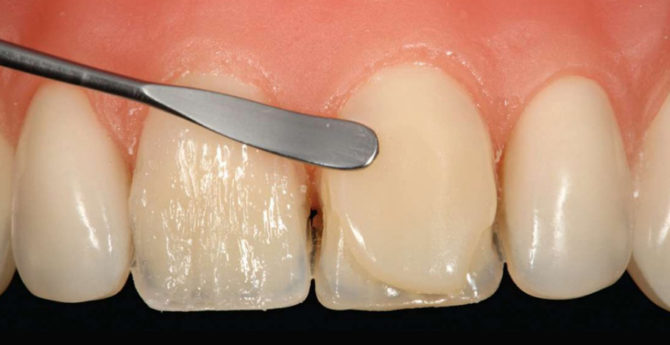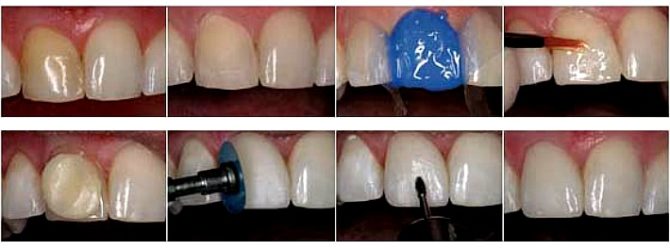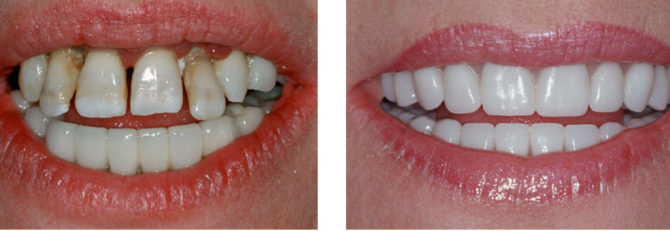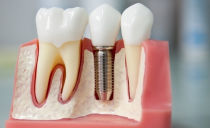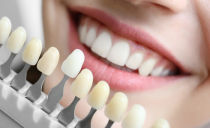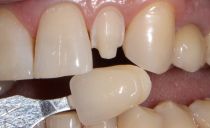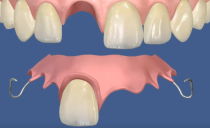Direct composite veneers: what is it, installation, indications and photos
Photos before and after installing composite veneers are amazing, so many dentist clients want to put just these tooth pads on themselves, expecting a stunning effect. But veneers are just decorative products used in dental clinics to improve the appearance of the dentition and are not suitable for everyone.
Content
- What are composite veneers and their composition
- Classification of composite tooth pads
- Indications for installation
- Contraindications to installation
- The advantages and disadvantages of veneering
- Steps for making direct composite veneers
- Product Life
- Componeer Direct Composite Veneers
- Photos before and after installing veneers by direct method
What are composite veneers and their composition
Composite (direct) veneers are special pads on the front surface of the teeth, which are made of composite materials in the patient's mouth. Reflective material is applied in layers directly to the surface of the teeth. For the procedure, one visit to the dentist is enough.
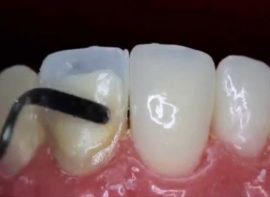 A composite is a three-dimensional spatial combination of two or more chemicals in which there is a clear interface - it can be seen even with the naked eye. This combination enhances the properties of each component several times.
A composite is a three-dimensional spatial combination of two or more chemicals in which there is a clear interface - it can be seen even with the naked eye. This combination enhances the properties of each component several times.
The first composite materials entered the dental market in 1964, but from that moment they evolved, became more convenient and safer for humans, because during this period:
- new adhesives were created;
- improved color scheme;
- the strength of the materials increased.
The main components of a modern composite:
- polymer matrix consisting of:
- a polymerization inhibitor that increases the shelf life of the substance;
- primary and secondary catalyst;
- activator;
- ultraviolet absorber, which prevents the discoloration of the linings under the influence of sunlight;
- inorganic filler, due to which:
- the aesthetic properties of microprostheses are increased, since the mineral filler has physical characteristics close to natural teeth;
- material deformation is prevented;
- the hardness and resistance of the composite increases;
- Surfactants or silanes are organosilicon compounds, due to which the strength of the material increases.
Of these three components, the properties and differentiation of the composite are most affected by fillers, which are classified based on the following characteristics:
- by material:
- from quartz;
- from silicon dioxide;
- from diamond dust;
- from barium glass;
- by the size of the filler particles there are composites from 0.04 to 45 microns;
- particle shape:
- sticks;
- antennae;
- spirals;
- shavings;
- dust;
- ground.
Most dental composites used to make veneers mainly consist of ground particles of barium glass, but much depends on the manufacturer.
Classification of composite tooth pads
Veneers made of composite material are classified based on the number and size of particles included in their composition. According to this criterion, composite pads are divided into:
- cheap veneers with large composite particles (more than 30 microns): they quickly fade and are not amenable to further processing;
- pads with minifill and particles up to 1.5 microns;
- hybrid composite veneers with particles about 1 micron in size;
- microprostheses with microparticles (up to 0.04 microns), used exclusively to restore the aesthetic appearance of the front teeth.
Indications for installation
Composite veneers perfectly mask the following dental defects:
- abnormal shape of the teeth;
- dental chips;
- wide gaps between the teeth;
- uneven contours of the front teeth;
- displacement of crowns in a vertical plane;
- yellow or gray spots on enamel, not amenable to bleaching;
- age-related changes in the shade of enamel;
- thinning of the teeth;
- defect of the filling material: discoloration of the seal, slight chip;
- increased abrasion of crowns.
The installation of veneer linings is shown if you need to visually correct the condition of several teeth in the smile area. But with significant defects, it is more advisable to use other dental methods for correcting the dentition.
Contraindications to installation
Direct veneering is contraindicated in the following cases:
- insufficient oral hygiene, as there is a high risk of tooth decay directly under the pads;
- the presence of carious cavities;
- malocclusion and the need to wear braces;
- the presence of inflammatory processes in the mouth;
- bruxism;
- tooth mobility;
- erupting wisdom tooth;
- the presence of depulped dental units, as they are more prone to destruction;
- severe enamel defects.
With the elimination of these pathologies, anyone can put direct composite veneers, and they will last quite a long time.
The advantages and disadvantages of veneering
The main advantages of composite veneers include:
- speed of manufacture and installation: you do not even need to make additional casts;
- durability subject to proper operation and quality care;
- beautiful appearance;
- maximum naturalness: modern composite materials transmit light well.
But composite veneers also have disadvantages:
- relative fragility, manifested if a person does not care for the pads and does not use suitable personal hygiene products;
- a small masking ability, manifested in the presence of teeth that are too dark in color or bright spots that are released (due to tetracycline);
- the need to grind enamel: after removing the veneers, the teeth need to be restored.
If only the central and lateral incisors are restored with the help of vining, then the remaining teeth often have to be whitened.
The quality of installation of vinyl microprostheses depends on the skill of the dentist. Not all dentists can put veneer linings beautifully, therefore, before installing them, it is recommended to check with the doctor his track record and ask for a photo of his work.
You should pay attention to the cost of veneers, as professionals do not work at the lowest prices. Approximate the average cost of one direct composite veneer in Moscow and St. Petersburg is 8–9 thousand rubles. for one tooth. The minimum prices for composite vinyl linings start at 4 thousand 500 rubles. Vining does not go through compulsory medical insurance because it is a cosmetic procedure.
Steps for making direct composite veneers
Lining on the tooth surface is best done in the morning, when it is light and sunny. This will help the dentist to correctly choose the shade of the material. Direct veneers are made in the patient's mouth. The whole procedure consists of several stages:
- Visual inspection and sanitation of the oral cavity. A few days before the procedure, you can go through a professional brushing session.
- The choice of shades of veneers on the Vita scale. The most responsible approach is to choose the color of the composite material in the event that you need to put literally 1-2 veneers and it is necessary that these overlays are no different from the rest of the dentition.
- Hardware turning of teeth on which composite material will be applied.
- Drawing layers of composite material on the frontal surface of the teeth. Typically, 7 layers of material are required to achieve maximum microprosthesis strength.
- Turning and grinding of veneers.
Product Life
Manufacturers of veneers claim that microprostheses can stand in the mouth for about 5-6 years, but in fact it is better to focus on a period of 3-4 years. Moreover, the overlay and luster will lose about a year after installation, which is associated with a large number of dyes used with food and a violation of the acid-base balance in the oral cavity.
The color change of veneers is facilitated by:
- Red wine;
- spices like curry;
- coffee;
- strong tea;
- colored fizzy drinks.
After veneering, it is recommended to abandon dyeing products or reduce their consumption to a minimum. If a person smokes, then it is better for him to install not composite, but ceramic veneers. Composites are easily stained by exposure to cigarette smoke.
Componeer Direct Composite Veneers
Componeers are used to improve the color of the surface of the teeth and to restore their shape. They are ready-made lining for enamel. The installation of comparators is faster and easier due to the fact that the time for preparing the oral cavity for restoration is reduced.
Compilers cannot be installed if:
- occlusion;
- periodontal pathologies;
- masticatory parafunctions;
- significant tooth decay.
Turning is not performed during the installation of components, which preserves the appearance and health of the treated teeth. If in the future it is necessary to remove microprostheses, additional restoration of enamel is not required.
Photos before and after installing veneers by direct method
Installing direct veneers made of composite materials is a relatively inexpensive way to make your smile beautiful and snow-white. This procedure is carried out for many pathologies, but the durability and naturalness of microprostheses depend on the professionalism of the dentist and the equipment of the dentistry clinic.

